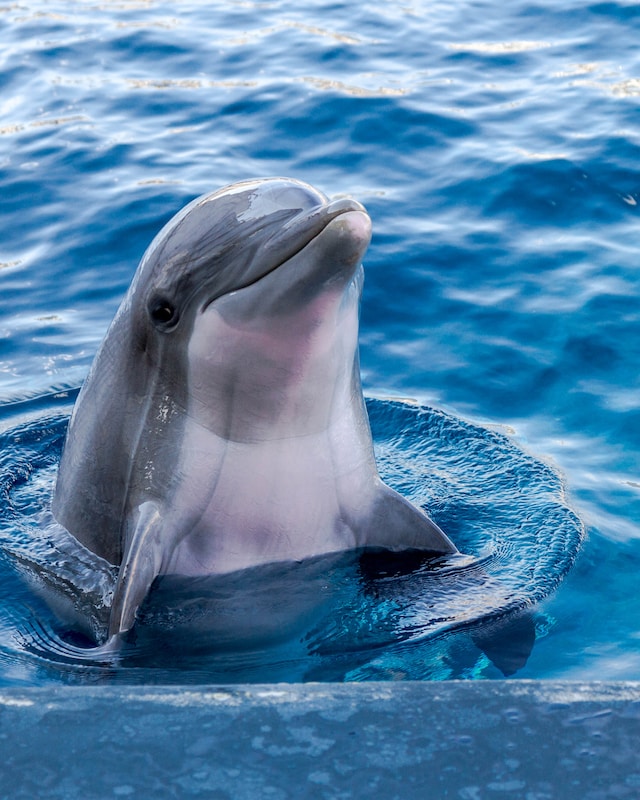
Dolphins have long held our attention with their intelligence, playful behaviors, and impressive acrobatic skills.
But one question often raised when viewing marine mammals like these dolphins is: Are dolphins warm-blooded creatures?
In this blog post we’ll dive deep into their fascinating world to determine this answer and uncover more mystery of our aquatic friends – whether or not we think they might actually be warm-blooded creatures!
Table of Contents
Are Dolphins Warm-Blooded?
Yes, dolphins are considered warm-blooded animals – meaning their body temperature remains consistent regardless of environmental temperature compared with cold-blooded organisms, like fish and reptiles which fluctuate according to environmental changes.
This makes dolphins an effective contrast when it comes to maintaining consistent body temperatures when living in cold environments such as fish tanks.
Warm-bloodedness is one of the principal advantages for dolphins, enabling them to thrive across an extensive variety of environments – even cold waters!
Dolphins use various adaptations that enable them to stay warm, including thick layers of fat (blubber) that insulates their bodies while the countercurrent heat exchange system transfers heat between its warm core and cooler extremities in order to conserve heat and conserve energy resources.
See Also: Are Dolphins Carnivores Herbivores Or Omnivores?
Are Dolphins Warm Or Cold Blooded?
Dolphins are warm-blooded animals known as endotherms. Endotherms, in contrast with cold-blooded or ectotherms species whose temperature fluctuates with their environment.
Here is a table that summarizes the key differences between warm-blooded and cold-blooded animals:
| Characteristic | Warm-blooded animals | Cold-blooded animals |
| Ability to regulate body temperature | Yes | No |
| Metabolism | High | Low |
| Physical adaptations to retain heat | Fur, feathers, blubber | None |
| Activity level | Relatively constant | Varies with environmental temperature |
| Examples | Mammals (Dolphins), birds | Fish, amphibians, reptiles, insects |
Why Is Dolphin Warm-Blooded?
Dolphins, like land mammals, are warm-blooded. Mammals use this trait to maintain constant body temperatures that support metabolism and other bodily processes. Being warm-blooded also allows mammals to operate effectively across many environments, including cold waters.
Dolphins possess several adaptations that aid them in staying warm, such as:
An abundance of blubber: Blubber acts like insulation to the dolphin’s body and helps it remain at an optimum temperature for life in water environments such as its ocean habitat.
Countercurrent heat exchange system: To conserve heat, this system helps the dolphin conserve heat by moving heat from its hot center out toward its cooler extremities.
Vasal constriction: In this process, blood vessels in a dolphin’s extremities constrict, decreasing blood flow to these regions while keeping its core warm.
Increased metabolic rate: An increase in metabolism helps generate heat when conditions become cold; particularly beneficial when temperature control becomes necessary for survival.

How Does A Dolphin Stay Warm?
Dolphins, like other warm-blooded mammals, employ several mechanisms to manage their body temperatures and stay warm regardless of environmental conditions:
Thick Layer of Blubber: Dolphins have a thick layer of blubber to insulate them from cold water. Dolphins possess an abundant layer of blubber under their skin that acts as insulation against cold waters.
It acts like an natural wetsuit to retain heat while remaining comfortable while swimming underwater. This rich in fat layer serves to preserve heat as well as retain it during periods of inactivity in cold waters keeping them at their preferred temperatures even on an underwater journey.
Countercurrent Heat Exchange: Dolphins employ an ingenious circulatory system called countercurrent heat exchange to maintain body warmth.
Arteries carrying hot blood from their heart are strategically situated close to veins delivering cooler blood from extremities, which allows heat from warm blood to be transferred directly onto cooler blood without it reaching body surfaces and increasing heat loss.
Physical Activity: Dolphins are very energetic animals. Their constant swimming and physical activity create heat internally that helps maintain an even body temperature.
Behavior Modification: Dolphins often swim together, which helps conserve heat. Furthermore, dolphins may engage in behaviors like leaping out of the water that exposes them to warmer air temperatures nearer to shore than at depth.
Selecting Appropriate Habitats: Dolphins inhabit waters where temperatures allow them to maintain an ideal body temperature level for themselves, such as during warmer winter seasons when migrating toward warmer waters or staying near shallower locations with relatively stable waters.
They might migrate further south during colder periods or stay put when temperatures fluctuate widely – these habitats should serve them well!
Are Dolphins Fish?
No, dolphins are not fish. Dolphins belong to the cetacean family of marine mammals and belong to this aquatic order.
Dolphins give live birth, nurse their young with milk as is typical with all mammals, while possessing complex social behaviors, communication capabilities and problem-solving capacities that make them highly intelligent creatures.
Fish are aquatic mammals with cold blooded circulatory systems and cold-blooded circulatory systems; they use their gills and fins for propulsion.
They lay eggs without producing milk to nourish their young; dolphins belong to one group called mammals while fish belong to an entirely separate category within animal kingdom.
Frequently Asked Questions (FAQs)
Do Dolphins Hibernate During Colder Months?
No, dolphins don’t hibernate during colder months – they continue swimming and hunting throughout the year as temperatures change in different waters, adapting their lifestyle according to changing temperature needs.
How Do Dolphins Survive In Both Cold And Warm Water?
Dolphins use insulation provided by their thick layer of blubber as well as their high metabolic rates to regulate their body temperatures in different aquatic environments.
Are There Different Species Of Dolphins With Varying Temperature Preferences?
Yes, different dolphin species inhabit various parts of the ocean with individual temperature preferences for different regions, though all dolphins are warm-blooded mammals.
Conclusion
Dolphins represent nature’s incredible adaptability through their warm-blooded nature.
By maintaining an optimal body temperature regardless of environmental influences, dolphins have proven that nature provides amazing adaptation capabilities that enable them to navigate vast oceans while flourishing in diverse habitats.
By studying these intriguing marine organisms more closely we gain more of an appreciation of this complex yet amazing world beneath the waves.

Mr. Das, a certified pharmaceutical scientist, holds a Bachelor of Science in Pharmaceutical Sciences and passionately contributes to dolphin conservation as a member of the committee in Bangladesh.


